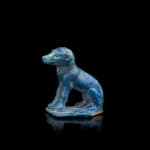Egyptian
An Egyptian faience seated dog, New Kingdom, circa 1200 BC
Faience
Height: 2.3 cm
Further images
The finely moulded statuette is composed of a dark blue glassy faience and is in the form of a dog seated back on its haunches, its tail curved around a...
The finely moulded statuette is composed of a dark blue glassy faience and is in the form of a dog seated back on its haunches, its tail curved around a hind leg, set on a small integral base.
Condition
Minor surface wear to the glaze with some discolouration and chipping. A chip to the reverse corner of the base. Some discolouration and spots of gilding around the neck, indicating it may originally have had a gilded collar, now worn off.
Condition
Minor surface wear to the glaze with some discolouration and chipping. A chip to the reverse corner of the base. Some discolouration and spots of gilding around the neck, indicating it may originally have had a gilded collar, now worn off.
Provenance
Jean Sigrist Collection, Basel, acquired in the 1960s - 1970s
With Galerie Nefer, Zurich, 2003
Private Collection, Switzerland
Exhibitions
On Loan: Antikenmuseum Basel & Sammlung Ludwig, early 1980s – 2022Literature
Dogs are the earliest domesticated animals (thought to be from around 10 000 BC in the Near East). They were used as guard dogs, for hunting, and as pets. Dogs are attested in Egypt already from the Predynastic Period, in paintings on pottery. In the Early Dynastic Period, Egyptians deposited faience figurines of animals in temple precincts. These figurines were reintroduced in the 12th Dynasty, but as a component of burial equipment and with new species added to the repertoire. The controlled representation of desert animals may have assured the Egyptians of eternal safety, though they also likely had symbolic meanings. The dog may represent a personal wish for companionship.There are a number of little statuettes of similar dogs in faience dating to the Middle Kingdom: see the Brooklyn Museum acc. no. 14.659, and the Metropolitan Museum of Art, New York, acc. no. 24.1.51, as well as acc. no. 08.200.36 for a fox. The upright posture of the hound sitting on its haunches is most characteristic of the New Kingdom onwards and the colour and format of the glaze also indicates a New Kingdom date. For similar see C. Andrews, Amulets of Ancient Egypt, London, 1994, fig. 60f.





